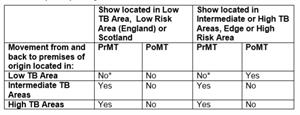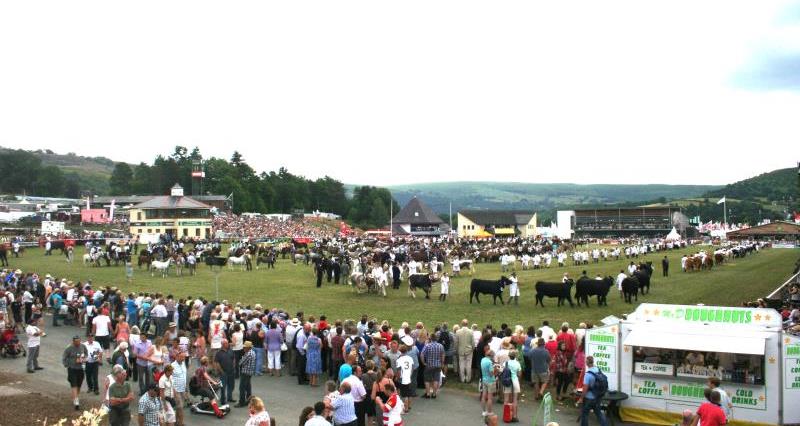Testing requirements for movements to and from Agricultural Shows
1. Do cattle on holdings in Wales need a PrMT and/or PoMT if they are moving to an exempt agricultural Show (i.e. one that is less than 24 hours in duration and/or unhoused) and returning to their premises of origin?
No.
2. Do cattle on holdings need a PrMT and/or PoMT if they are moving to an exempt agricultural Show (i.e. one that is less than 24 hours in duration and/or unhoused), but not returning to their premises of origin?
Yes. There is no PrMT and no PoMT exemption if not returning to the premises of origin.
3. Can cattle, which have moved onto a holding in the Low TB Area and which require a PoMT, move off the holding to an exempt agricultural show, prior to a clear PoMT?
No.
4. Do cattle moving to a non-exempt Show (i.e. one that is longer than 24 hours in duration and/or is housed) need to be Pre-Movement Tested?
Cattle from the High TB Areas and Intermediate TB Areas will need a PreMovement Test before being moved to a non-exempt Show. Cattle from the Low TB Area will not need a Pre-Movement Test if moving to a non-exempt Show, unless:
- The Show has specified testing as a requirement (for example the Royal Welsh Show and Winter Fair), and/or
- The herd is either undergoing post TB breakdown testing or contiguous testing. In these cases, bovine animals of 42 days and over will need to be Pre-Movement Tested before leaving the holding, until the herd returns to normal TB surveillance testing.
5. What are the Post-Movement Testing requirements for cattle returning, or moving to the Low TB Area from a non-exempt Agricultural Show?
Cattle will need to be Post-Movement Tested between 60-120 days after returning, or moving to the Low TB Area from a non-exempt show, located in the Intermediate or High TB Areas in Wales, Edge or High Risk Areas of England.
A general licence will enable cattle to move from a non-exempt show in the Low TB Area of Wales, without a post-movement test. The licence will require those cattle sold at a non-exempt show in the Low TB Area, which have originated from herds in the Intermediate, or High TB Areas of Wales, or the Edge, or High TB Area of England to move to the Low TB Area, but will require a post-movement test. The conditions of the general licence can be found here.
6. I am in the Low TB Area and I move my cattle to exempt and nonexempt Agricultural Shows across Wales (and England) during the show season?
A summary of key changes are as follows: 
*PrMT is exempt, unless:
- The Show has specified testing as a requirement (for example the Royal Welsh Show and Winter Fair), and/or
- The herd is either undergoing post TB breakdown testing or contiguous testing. In these cases bovine animals of 42 days and over will need to be Pre-Movement Tested before leaving the holding until the herd returns to normal TB surveillance
7. When do my cattle need a Post-Movement Test?
Animals, which require a Post-Movement test following return from a nonexempt show to the Low TB Area will only be allowed to move off to exempt and non-exempt Shows during the season if they:
- Have received a Post-Movement test with clear results; or
- Move into a certified Quarantine Unit (QU), are licensed to move off before a Post-Movement test and remain in the Quarantine Unit (when not at a show) through the show season, until a final Post-Movement test has been completed with clear results. A Post-Movement test will be required at 60-120 days after the initial movement back from a nonexempt show located in the Intermediate, or High TB Area of Wales, or the Edge, or High TB Area of England to the Quarantine Unit. Bovine animals must be moved out of the QU immediately after satisfying the post- movement testing requirements.
The movements of show cattle from the Low TB Area to and from agricultural shows and back into a QU, are covered by a general licence. The conditions of the general licence can be found here.
The conditions include a requirement to notify APHA of the first movement of a bovine animal into a QU and the final movement of a bovine animal into the QU. The final movement back into the QU must be in the same calendar year, as the first movement in, to ensure that a final post-movement test is completed.
Ad-hoc inspections to ensure the cattle are retained in the QU may be carried out by APHA and any breaches of conditions of the licence may result in the licence being revoked for an individual holding for a specified period.
8. Why are you requiring use of a certified Quarantine Unit to enable multiple movements to and from Shows?
Use of the QU will protect a keeper’s own herd and will reduce the risk of disease being spread within the Low TB Area prior to completion of PostMovement Testing. Otherwise, the keeper would not be able to move his cattle to multiple Shows within the Show season because the animals must remain on the holding until completion of a clear Post-Movement Test.
9. Am I able to use my Quarantine Unit for Six day standstill and show purposes at the same time?
There should be no mixing of animals within the Quarantine Unit whilst it is being used for show animals – this means that sheep and cattle moving on and off the farm in the normal course of events either trigger the 6 day standstill or move through a separate QU. This would include show sheep and goats. We recognise that mixing during transit may institute a risk, however, our advice would be not to mix species during transit, where practicable.
Allowing sheep into the same QU as the show cattle needlessly extends the period of contact.
10. If I am showing dairy cattle will I be able to move them into my usual milking parlour while they are in the Quarantine Unit?
Lactating animals must not leave a QU to be milked, and the sharing of milking facilities between quarantined and non-quarantined animals is not permitted. If dairy animals enter the QU, dedicated temporary milking facility can be used within the QU itself, provided any portable equipment is not moved out of the QU, before thorough cleansing and disinfection has taken place.
Milk from animals within the QU can be sold in the normal way, but must not be fed to other animals on the main holding (including cats and dogs).
11. Shows less than 24hrs in duration and/or do not involve housing are exempt from PrMT / PoMT rules. Does this include tents/ marquees?
Tents and marquees (even those with no sides) are considered to be housing and are not exempt from PrMT/PoMT requirements.
12. Has industry been consulted on this issue?
The Welsh Government has discussed options for protecting the Low TB Area from disease imported back from shows outside of the Low TB Area, with representatives of the Association of Show and Agricultural Organisations (ASAO) and the Royal Welsh Agricultural Society (RWAS) and assimilated their concerns while developing this policy.
13. What are differences between a Quarantine Unit certified by the Welsh Government and an isolation facility?
An isolation facility is any building, or outside area, which has biosecurity measures in place to prevent either direct, or indirect contact of isolated animals through a shared airspace, the drainage or disposal of excreta, or the shared use of equipment with other animals on the premises. They may be used to prevent the onward transmission of disease from moved in animals, whose disease status is unknown, until testing for the disease is complete. They may also be used to contain the spread of disease from an already infected animal, or animals.
A Quarantine Unit (QU) certified by a certification body, on behalf of the Welsh Government is a specific type of isolation facility, developed by the Welsh Government, for cattle, sheep, or goats, moving on to a holding, to provide short term accommodation, in order to negate the requirement for the whole holding to be subject to the 6 day standstill. They operate to specified operational rules and requirements, to prevent contact with other animals on the holding and are approved by a certification body.
A Certified QU provides an appropriate level of biosecurity; they are inspected, to ensure standards are maintained and that they are being used appropriately. Certified Quarantine Unit requirements and operational rules, following a public consultation, were agreed by the Welsh Livestock
Identification Group (LIDAG) and delivery partners. The proposals were also subject to a thorough Veterinary Risk Assessment.
For use under the General Licence for cattle moving to and from non-exempt shows in the Low TB Area, a certified QU must only contain similar cattle moving to and from exempt shows.
Certified Quarantine Unit requirements and operational rules may be similar to those for other isolation facilities, depending on the use and requirements for those isolation facilities and whether they are part of a requirement for a scheme, such as the industry TB Cattle Health Schemes, operating under CHeCs.
More information and frequently asked questions relating specifically to Quarantine Units can be found here.
14. What is the difference between a Quarantine Unit and a TB Isolation Unit?
TB Isolation Units are approved by APHA for TB restricted holdings, enabling a group of young cattle, to regain OTF status, under a separate TB testing regime from the main herd. They must be located away from the main holding, in a unit with high biosecurity measures in place, under a separate holding number and requiring a licensed movement to the unit. Mitigation of risk of potential disease spread, is one of the main factors in approving such units. TB Isolation Units can only be set up outside the Low and Intermediate North TB Areas. They cannot be set up in the Intermediate Mid TB Area, for calves originating from TB restricted herds in a High TB Area. They can only accept calves under 42 days old and must be filled within a 6 week period.
Isolation facilities may also be agreed by APHA, on a TB restricted holding, to mitigate against the risk from and to animals purchased onto the premises under a licence, following a Veterinary Risk Assessment.
15. How do I apply for a Quarantine Unit?
QUs must be certified by a Certification Body accredited by the United Kingdom Accreditation Service (UKAS). There is currently one Certification Body accredited to certify QUs:
Quality Welsh Food Certification Ltd. Email: aW5mb0Bxd2ZjLmNvLnVr Tel: 01970 636 688
You should contact the Certification Body, who will be able to provide you with QU standards and operational rules. Once you have set up your QU in adherence to the standards provided, you should contact the Certification Body to arrange for it to be reviewed and certified. Certification Bodies will charge a fee for this service.
~ ~ ~ ~ ~ ~ ~ ~ ~ ~ ~ ~ ~ ~ ~ ~ ~
Visit NFU Cymru's livestock page here
~ ~ ~ ~ ~ ~ ~ ~ ~ ~ ~ ~ ~ ~ ~ ~ ~
